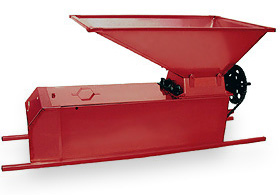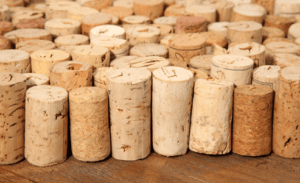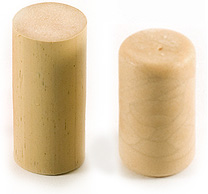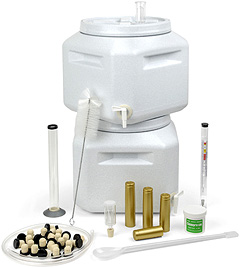 Great news! A great deal has just gotten better. We’ve just lowered the price of our Marchisio Grape Crusher / Grape Destemmer by $76.04. This makes the new price $698.28. And that includes FREE shipping to anywhere in the 48 states.
Great news! A great deal has just gotten better. We’ve just lowered the price of our Marchisio Grape Crusher / Grape Destemmer by $76.04. This makes the new price $698.28. And that includes FREE shipping to anywhere in the 48 states.
This unit is both a grape crusher and grape destemmer. It crushes the grape clusters through two roller mills and then drops them into a trough where it removes the stems. The only thing that goes in your fermenter are crushed grapes.
Not only does it do a beautiful job of preparing your grapes for fermenting, it’ll save you a lot of work and a lot time. It is able to easily handle over 2000 lbs. of grapes in a single hour. Just crank the handle at a normal, human speed and the grape destemmer does all the rest.
This is no toy. This is the real-deal. Made by Marchisio (mar-Ke-zee-oh) of Italy, a world leader in winery equipment. Visit our website to learn more and to place your order. This price will only last until we run out of our current stock.
———————————–
Ed Kraus is a 3rd generation home brewer/winemaker and has been an owner of E. C. Kraus since 1999. He has been helping individuals make better wine and beer for over 25 years.
Category Archives: Wine
Keeping Your White Wines White (Part III)
 In this last post of a III part series we’ll go over the importance of using sodium metabisulfte when racking you wines.
In this last post of a III part series we’ll go over the importance of using sodium metabisulfte when racking you wines.
Keeping air exposure to a minimum also means that great care should be taken when racking your wine. Eliminate as much splashing as possible. Splashing will only introduce more air into the wine. You can do this by making sure the siphon hose fills the wine carboy or vessel from the bottom up. In other words, keep the end of the hose down into the wine as it is filling up the wine carboy.
Also, for rackings that are done after the fermentation has completed, sodium metabisulfite should be added directly into the wine. If the fermentation is not complete, sodium metabisulfite should not be added. It could interfere with the fermentation or wine brewing.
Sodium metabisulfite will release sulfur dioxide gas (SO2) into the wine driving out any oxygen that may have saturated into the wine during racking. As an added bonus it will also destroy any unwanted microorganism that may have gotten into the wine as well.
Because much of SO2 naturally wants to leave or dissipate from the wine it needs to be replenished at every racking. Unless you have a way of testing for sulfur dioxide (SO2) levels, how much to add can be somewhat of a guessing game. I normally add half of a full dose at rackings. This comes out to 3/16 of a teaspoon for a 6 gallon batch of wine, or 1 teaspoon to every 32 gallons of wine.
We have titration kit that is used to measure the level of SO2 in a wine at any given time. This is the most accurate way to go, and it is also what I would recommend doing if you have a larger batch of wine at stake.
The titration kit measures SO2 in parts-per-million or (P.P.M.). During rackings you would like the wine to maintain a level of SO2 at about 30 P.P.M. At bottling time you would like to raise this level to about 50 to 60 P.P.M. This is the same level found in commercially made wines.
Having this level of SO2 in the wine while it is in the wine bottle will protect it from spoilage and help to keep it stable. Eliminating this step does not mean that your wine will immediately show signs of oxidation, however it will be much more susceptible to it.
———————————————————————————————————
Ed Kraus is a 3rd generation home brewer/winemaker and has been an owner of E. C. Kraus since 1999. He has been helping individuals make better wine and beer for over 25 years.
Keeping Your White Wines White (Part II)
 In part I of this III part series we introduced you to the effects oxygen can have on a wine. In this post, part II, we’ll start to go over what can be done to keep the effects of oxidation under control.
In part I of this III part series we introduced you to the effects oxygen can have on a wine. In this post, part II, we’ll start to go over what can be done to keep the effects of oxidation under control.
Oddly enough, limiting air exposure during the fermentation is not the answer. Air is needed for the wine to ferment to its fullest potential. The carbon dioxide that is produced during the fermentation keeps excessive amounts of air from coming in contact with the wine. In fact, the fermentation can be conducted completely exposed in an open fermenter as opposed to a wine carboy with no problems at all.
It is after the fermentation, that air can become an issue. Care should be given from this point on, all the way through to the bottling of the homemade wine. Air contact should be kept to an absolute minimum during this time. This means that any head-space that is in the wine carboy or fermenter should be eliminated. This can be done in several ways:
- The wine can be moved to a smaller, more appropriated-sized carboy or even several gallon glass carboys.
- Glass marbles that have been sanitized with sodium metabisulfite can be put into the wine to increase its volume.
- A similar wine can be added to the batch to increase its volume. This can be wine you’ve made or even store bought wine.
Limiting air exposure also means that great care should be taken when racking the wine. In the last part of this III part series we’ll go over the issues faced when racking a wine and the role sodium metabisulfite plays in the process.
———————————————————————————————————
Ed Kraus is a 3rd generation home brewer/winemaker and has been an owner of E. C. Kraus since 1999. He has been helping individuals make better wine and beer for over 25 years.
Keeping Your White Wines White (Part I)
 Wine Making Tips On How To Make White Wines.
Wine Making Tips On How To Make White Wines.
This is part I of a III part series on what to do to keep your homemade white wines, looking white.
The Battle At Hand
One of the biggest concerns when making white wine is oxygen. When oxygen in the air comes in contact with the wine it can cause it to oxidize. In serious cases the wine may even start to turn brown or orange. The wine can also take on a carmel or raisin character which may, or may not, be okay depending on the type of wine involved.
In the specific case of red wines, some oxidation can occur with little or no noticeable detriment to the wine. The bolder flavors and color of reds tend to hide the subtler effects oxidation can have. In fact in the case of some of the bigger reds, the effects of oxidation can even improve the wines overall depth and complexity.
With white wines this is not the case. Color and flavor mutations are more easily detected and unless you are trying to emulate a port or sherry wine of sorts you do not want any of its effects in the wine. To say it a different way, whites are more delicate and less forgiving than reds. Care has to be taken to preserve its freshness and color.
What To Do
Having said all this, one starts to wonder what should be done to limit the effects of oxygen on white wines, particularly if it is so important to learning how to make white wines. In the next post we will start to look at some of the ways to keep oxidation under control.
———————————————————————————————————
Ed Kraus is a 3rd generation home brewer/winemaker and has been an owner of E. C. Kraus since 1999. He has been helping individuals make better wine and beer for over 25 years.
Selecting Wine Corks
 When selecting corks for your homemade wine remember that appearance is not everything. In today’s market there are a lot of pretty corks, but pretty does not make the cork good.
When selecting corks for your homemade wine remember that appearance is not everything. In today’s market there are a lot of pretty corks, but pretty does not make the cork good.
If there is one wine making tip I can give it is to look closely at what you are purchasing. You have to consider that your cork is the final piece of your wine preservation system and great care should be taken to see that wine is sealed up properly for bottle aging.
When you buy corks, you should ask yourself if they are real, solid corks or not. This is because a lot of corks that are currently on the home wine making market are nothing more than ground-up bits of cork that have been glued together and reformed into the shape of a cork. These corks are cheaper because they are made from poor-quality scrap cork that would have never been able to be used to make a wine cork otherwise.
Other than synthetic corks, all the corks we offer are real, solid corks. All of them have been cut directly from cork tree bark and will seal your wine bottles for ultimate bottling aging. Real cork does make a difference.
How Are Synthetic Corks Made? (Part II)
 In part I of this two part series, we talked about the two major ways that synthetic corks are produced. In today’s post I would like to continue those thoughts and go over the significance these two production methods have on the resulting synthetic corks and in what way these corks affect the wine they are sealing.
In part I of this two part series, we talked about the two major ways that synthetic corks are produced. In today’s post I would like to continue those thoughts and go over the significance these two production methods have on the resulting synthetic corks and in what way these corks affect the wine they are sealing.
As stated before, with the extrusion method the synthetic corks’ inner elastic foam is exposed on either end of the cork. With injection molded synthetic corks none of the inner elastic foam is exposed. The elastic foam is completely sealed by its outer shell.
With extruded corks, absorption of wine into the elastic foam may be an issue. Foam of this type provides an incredible amount of surface area to come in contact with the wine as it is drawn into to the cork. Over time this may lead to the transfer off-flavors from the cork to the wine. The jury is still out on this issue. We’ll have to wait to see.
Some extruded synthetic corks can have slightly frayed corners because they are cut from a longer extruded piece. This fraying can cause a bottle of wine to have a plastic flake in it every now and then. Again, injection molded synthetic corks do not have this issue because they are not cut in anyway and there are no Sharp edges.
Some extruded corks have had a chamfer ground into its cut edge. This eliminates the fray and make them easier to extract when it is time to decant the bottle. If you do decide to by extruded synthetic corks, these are the kind we would suggest.
Just from a general aesthetic view, injection molded corks look closer to a natural cork than their extruded counterparts. Except for their size, extruded corks don’t really look anything like a natural wine cork.
For these reasons, if you decide to go with the synthetic when it comes time to buy corks, we recommend that you purchase injection molded synthetic corks as opposed to extruded corks. The cost is about the same, and you’ll get a better cork.
The is part II of a two part series. Read How Are Synthetic Corks Made? (Part I) here.
———————————————————————————————————
Ed Kraus is a 3rd generation home brewer/winemaker and has been an owner of E. C. Kraus since 1999. He has been helping individuals make better wine and beer for over 25 years.
Homemade Wine And Weddings…
 Do you have a wedding in the family that’s coming up? Why not present your own homemade wine as a personalized wine gift. It’s a touching way of saying congratulations.
Do you have a wedding in the family that’s coming up? Why not present your own homemade wine as a personalized wine gift. It’s a touching way of saying congratulations.
You can personalize the wine bottle labels on each of the bottles with your own personal message to the bride and groom. We offer customizable wine labels that you can run through any computer printer to have them say anything you want. You can put there names on the label with the wedding’s date, a toast, or anything else you’d like to say.
Here’s an example of what you could say: Congratulations! Ashly & Eric, June 15, 2010, To Many Happy Years Of Marriage. Put a bottle on each table at the wedding reception. What could be nicer?
We have several different wine bottle labels to choose from. Just select the design you like the best. Type a message on your computer using a word processor such as Word or Word Perfect and you’re all ready to go.
———————————————————————————————————
Ed Kraus is a 3rd generation home brewer/winemaker and has been an owner of E. C. Kraus since 1999. He has been helping individuals make better wine and beer for over 25 years.
Learn Why Wine Making Today Is Easy
 Think making great homemade grape wine is hard? Well, guess again! Today, you can make your own incredible wines that rival those you find on the store shelf, and it’s easy.
Think making great homemade grape wine is hard? Well, guess again! Today, you can make your own incredible wines that rival those you find on the store shelf, and it’s easy.
A lot has changed over the past few years in the home wine making world. Wine making products have become easier to use and have become more abundant. The breadth of selection is staggering.
We currently offer over 200 different grape juices collected from vineyards around the world. The grapes are grown in the same fields used by professional wineries: Cabernets, Chardonnays, Merlots, Pinot Blancs… The list goes on and on.
What makes these wine making juices so easy to use is that the crushing and pressing of the grapes have already been taken care of for you. Great care is taken during these processes to make sure that each juice has the proper body, balance and pH for making a stellar wine.
These juices also come with very clear homemade wine instructions. They are very specific and assume you know absolutely nothing about making wine. They are step-by-step detailed directions that have been tested time and time again for clarity and understanding. You can see for yourself just how easy the directions are to follow.
If you’ve been tossing around the idea of making some homemade wine, then there’s no reason to wait any longer. Now’s the time. What’s available in today’s market makes successful home wine making a breeze. Visit our website or give us a call: 1-800-353-1906. We’ll be more than happy to help get you started.
———————————————————————————————————
Ed Kraus is a 3rd generation home brewer/winemaker and has been an owner of E. C. Kraus since 1999. He has been helping individuals make better wine and beer for over 25 years.
Having The Right Homemade Wine Equipment For The Job
 When making homemade wine equipment is important. Without having the proper equipment, not only will making the wine be more difficult, but it can even compromise the quality of your wine.
When making homemade wine equipment is important. Without having the proper equipment, not only will making the wine be more difficult, but it can even compromise the quality of your wine.
Fortunately, the list of wine making equipment that you really should have is not all that long. You’ll need a couple of containers or plastic fermenters that you can be fitted with air-locks for fermenting the wine, some vinyl hose for transferring the wine from one container to the next, a stirring spoon of some kind to mix everything up, and most importantly, a gravity hydrometer to track the progress of your fermentation and to determine when and if the fermentation is complete.
Of course, there are other little gadgets, doohickeys and various other wine making materials that you may decide that you want to get later on, but for now these are the essential aliments that you will need to get you started.
All these items can be purchased individually on our website, or you can purchase them all together at a reduced price. We offer all these items together as a wine making starter equipment kit. It includes all the items listed above: the fermenters with air-locks, hose, stirring spoon and the hydrometer.
In addition, it also includes a wine bottle brush for cleaning dirty wine bottles, cleaning solution to sanitize your wine bottles, a test tube to use when taking readings with the hydrometer, wine bottle stoppers that can be put in by hand and decorative bottle neck covers to give your wine bottles a professional look.
With this homemade wine equipment kit you can easily make wine using any of the wine making ingredient kits listed on our website. Currently we have over 200 different ones to choose from. Each comes with the juice and additional little of packets of ingredients you will need, such as yeast, clarifiers, etc.
———————————————————————————————————
Ed Kraus is a 3rd generation home brewer/winemaker and has been an owner of E. C. Kraus since 1999. He has been helping individuals make better wine and beer for over 25 years.
How To Make White Wine With Vigilance
 A friend of mine asked me the other day how to make white wines from fresh grapes. The question came at me completely out of the blue and kind of knocked me for a loop. My friend has been around wine making by way of being around me for some time, but he has never shown any interest in making any wine of his own.
A friend of mine asked me the other day how to make white wines from fresh grapes. The question came at me completely out of the blue and kind of knocked me for a loop. My friend has been around wine making by way of being around me for some time, but he has never shown any interest in making any wine of his own.
I told them the process is not so different from making a red wine. Procedure-wise, the only difference was that with white wines you press the grapes before fermentation. With red wines you press the grapes after fermentation.
But there’s another aspect to making a white wine, one that doesn’t involve procedure as much as it does finesse. White wines are more delicate than reds. If there are any off-flavors or aromas in a white wine it shows much more clearly than if it were a red. Another way to say it is, whites are less forgiving.
In general, when you talk to someone about how to make your own wine, you usually talk in terms of procedures, but when you talk about how to make white wines, specifically, you talk in terms of vigilance. Vigilance toward keeping the equipment sanitized. Vigilance toward keeping air exposure to a minimum. Vigilance toward making sure the fermentation environment is optimum. Keeping your wine yeast out of stress will result in a cleaner tasting wine.
I explained all this to my friend and he said he understood. He told me how he was starting to see how making white wines could be more of a challenge. Not that they shouldn’t be made, but one should get in the right frame of mind before beginning such a project.
To sum it all up, if you’re the type that likes to get a wine going and–except for a few rackings–just let it do its own thing, you may to stay away from making white wines, from fresh grapes anyway. These wines are more demanding and require more attention than you are willing to give. However, if you like the intricacies of wine making and don’t mind baby-ing a batch here or there, you may be the perfect candidate for making white wines.
In either case, realize that you can still make exceptional white wines from wine concentrates. By taking the crushing, the pressing and the clearing of the pulp out of the equation anyone can make incredible white wines with a concentrated grape juice for wine making.
———————————————————————————————————
Ed Kraus is a 3rd generation home brewer/winemaker and has been an owner of E. C. Kraus since 1999. He has been helping individuals make better wine and beer for over 25 years.
